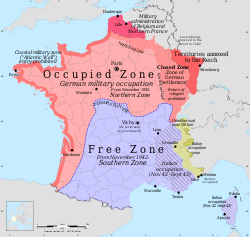Originally set in France, 1944
Yes, technically the play occurs in hell. However, all the characters are from Paris around the time of 1944. Therefore I will try to understand the nature of the location at this date to better understand the characters.World War II effected Paris, France, a great deal
From 1940-1944 Paris, France, was overtaken by German forces. The north half became "occupied", while the lower half stayed unoccupied by the invading armies. Central Paris survived the war unscathed, despite the order having been given to the German commander to destroy the city before he fled. After the war, the suburbs exploded in size and popularity. In addition, large social estates and a comprehensive express subway network were built. A freeway was established the circled Paris via the surrounding suburbs.
Existentialism was a means of rebellion in 1940s France
Following the Second World War, existentialism became a well-known and significant philosophical and cultural movement, mainly through the public prominence of two French writers, Jean-Paul Sartre and Albert Camus, who wrote best-selling novels, plays and widely read journalism as well as theoretical texts. These years also saw the growing reputation of Heidegger's book Being and Time outside of Germany.SOURCE
World War II also effected the fashion of France
World War ll had an effect on the fashion industry everywhere even in the home of haute couture, Paris. After the Nazis occupied Paris they insisted that the fashion industry be transferred to Berlin, and although they did eventually withdraw the order several couture houses closed down. 'Coco' Chanel shut up shop a year before the outbreak of war and later benefited by having a top Nazi official as her lover. A lot of other top designers either retired or went into exile.
Expensive fabrics such as silks and lace were no longer available in Paris and ordinary fabrics were restricted. This, along with the mass exodus of the Jewish fashion workforce (they were either forced to go abroad or further south e.g. Nice) meant the collapse of the French fashion industry centre. Few fashion houses continued in their pre-war status but worked mainly for wealthy collaborators or exported designs to Germany.
The designs at that time in France were full skirts, high-heeled shoes and even fur coats for those who could afford them. The French designers argued that their designs were in defiance of the German restrictions and also meant that there was less fabric available to the enemy. In Paris, women began to make the hat their expression of fashion, as material was rationed, but flowers and feathers were not. So an explosion of colour and style could be seen on the heads of many women.
Expensive fabrics such as silks and lace were no longer available in Paris and ordinary fabrics were restricted. This, along with the mass exodus of the Jewish fashion workforce (they were either forced to go abroad or further south e.g. Nice) meant the collapse of the French fashion industry centre. Few fashion houses continued in their pre-war status but worked mainly for wealthy collaborators or exported designs to Germany.
The designs at that time in France were full skirts, high-heeled shoes and even fur coats for those who could afford them. The French designers argued that their designs were in defiance of the German restrictions and also meant that there was less fabric available to the enemy. In Paris, women began to make the hat their expression of fashion, as material was rationed, but flowers and feathers were not. So an explosion of colour and style could be seen on the heads of many women.
Paris' Social Culture secretly thrived during the war
Far from closing down Parisian social life, the Germans exploited the city’s cultural and entertainment resources as an opulent recreational area for their soldiers and officials. Soon after the occupation, theatres re-opened, playing to capacity audiences of French and Germans alike. It was a time of expansion for the city’s nightclubs as well. About 125 of central Paris’s 200 cabarets were founded after the 1940 armistice.Jazz achieved unprecedented popularity in the occupied nations of Europe and even in Germany during the war, but nowhere more so than in France. Paris concerts had traditionally attracted audiences of around 400. Now even those performances in provincial towns featuring lesser artists, attracted audiences of a thousand or more. Record sales also increased. Many of these were recordings of French artists playing American-style swing. Undoubtedly jazz fulfilled the desire for escape of many in the occupied nations; it was a reminder of a different time and a different place.
SOURCE
French Cinema thrived under German influence
French society has long been proud of the quality of films produced during the war under German Occupation, and indeed several of them have never fallen from favour—Les Visiteurs du soir and Les Enfants du paradis, for instance, not to mention Cocteau’s L’Eternel Retour and Grémillon’s two films. But others that adopted the Vichy ideology of back to the land, and others again that were subsequently interpreted as resistance films, are also well worth seeing.
